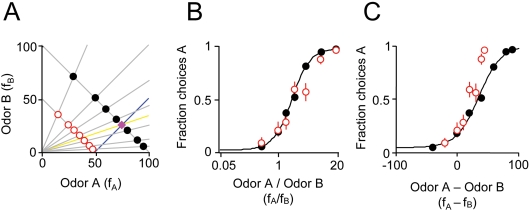Figure 3.
Odor mixture discrimination boundary is not necessarily orthogonal to the training set. (A) Training stimuli (fA + fB = 100; black filled circles) and lower concentration test stimuli (fA + fB = 50; red circles). The training reward boundary is indicated by the magenta diamond. Note that the boundary shifted in this experiment to fA = 3·fB. The yellow line indicates the classification boundary for a ratio computation (fA/fB = 3) while the blue line indicates the classification boundary orthogonal to the training stimulus set (y = fA − fB = c). See also Figure 1A for details of legend. (B) Performance of one rat on training and test stimuli with a shifted training reward boundary. The independent variable is the ratio of mixture components fA/fB. (C) The same data as in (B) but where the independent variable is the difference of mixture components, fA − fB.

